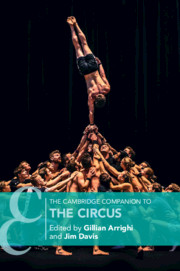Book contents
- The Cambridge Companion to the Circus
- Cambridge Companions to Theatre and Performance
- The Cambridge Companion to the Circus
- Copyright page
- Contents
- Figures
- Contributors
- Acknowledgements
- Timeline
- Introduction
- Part I Transnational Geographies of the Modern Circus
- Chapter 1 The Origins and Growth of the Modern Circus
- Chapter 2 Reconstruction, Railroads, and Race
- Chapter 3 Circus, Colonialism, and Empire
- Chapter 4 The Criollo Circus (Circus Theatre) in Argentina
- Chapter 5 The Past and Present of Czech Circus
- Chapter 6 Catching On
- Part II Circus Acts and Aesthetics
- Part III Circus
- Part IV Circus Studies Scholarship
- Bibliography
- Index
- References
Chapter 5 - The Past and Present of Czech Circus
from Part I - Transnational Geographies of the Modern Circus
Published online by Cambridge University Press: 22 June 2021
- The Cambridge Companion to the Circus
- Cambridge Companions to Theatre and Performance
- The Cambridge Companion to the Circus
- Copyright page
- Contents
- Figures
- Contributors
- Acknowledgements
- Timeline
- Introduction
- Part I Transnational Geographies of the Modern Circus
- Chapter 1 The Origins and Growth of the Modern Circus
- Chapter 2 Reconstruction, Railroads, and Race
- Chapter 3 Circus, Colonialism, and Empire
- Chapter 4 The Criollo Circus (Circus Theatre) in Argentina
- Chapter 5 The Past and Present of Czech Circus
- Chapter 6 Catching On
- Part II Circus Acts and Aesthetics
- Part III Circus
- Part IV Circus Studies Scholarship
- Bibliography
- Index
- References
Summary
Circus has been an inherent part of the Czech cultural milieu since the nineteenth century when emerging circus arts were closely associated with folk puppetry. From humble beginnings as street acts, Czech circuses developed into large-scale business operations that were nationalised in the 1950s during the Communist regime and then transformed into freely functioning communities and enterprises after the Velvet Revolution of 1989. A distinct Czech variant of contemporary circus has emerged recently, born of and significantly influenced by the world of theatre. In the Czech Republic one may observe, side by side, traditional circus, which has largely continued to adhere to its original artistic code, and contemporary circus, which is currently attempting to create an innovative code well-suited to the twenty-first century. This chapter focuses on the origin and transformation of traditional and contemporary circus forms, their characteristics, and their status (both artistic and economic) in the current Czech sociopolitical milieu. There are overlaps with Polish, Slovak, and Hungarian circus environments because, as with the present-day Czech Republic, all of these countries have undergone significant cultural and political transformations since the fall of Communism in 1989. It is precisely this shared history which provides the authors with a unique perspective upon Central European circus.
Keywords
- Type
- Chapter
- Information
- The Cambridge Companion to the Circus , pp. 78 - 91Publisher: Cambridge University PressPrint publication year: 2021
References
Further Reading
- 1
- Cited by



